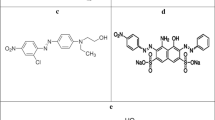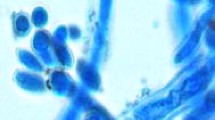Abstract
The diverse group of endophytic fungi was isolated from Euphorbia milii, an ornamental plant, plated on lignin-based potato dextrose agar. The laccase-producing fungi were screened with alpha-naphthol. Initially, one variable at a time method was used for optimization of the low-cost media for laccase production, and the following parameters were used: carbon source (glucose), nitrogen source (sodium nitrate), pH (7), agitation (120 rpm), amount of mineral solution (2 mL), incubation period (\(28\,^{\circ }\hbox {C}\)) and duration (5 days). The efficiency of media for laccase production was statistically analysed. The optimized laccase production in response surface model was predicted using an artificial neural network with net regression value of 0.98. The final optimum media conditions for laccase production were as follows: carbon source (sodium potassium tartrate (1.4 g/L)), nitrogen source (sodium nitrate (1 g/L)), mineral solution (1 mL), inducer (copper sulphate 0.1 g/L and potassium chloride 0.5/L), pH (5), incubation (120 rpm), temperature (\(28\,^{\circ }\hbox {C}\)) and duration (7 days). The lowest laccase production in response surface model was 38.25 U/L and the highest laccase production was 122 U/L on the 7th day.
Similar content being viewed by others
References
Chandra, R.; Chowdhary, P.: Properties of bacterial laccases and their application in bioremediation of industrial wastes. Environ. Sci. Process. Impacts 17, 326–42 (2015). https://doi.org/10.1039/c4em00627e
Salvachúa, D.; Karp, E.M.; Nimlos, C.T.; Vardon, D.R.; Beckham, G.T.: Towards lignin consolidated bioprocessing: simultaneous lignin depolymerization and product generation by bacteria. Green Chem. 17, 4951–4967 (2015). https://doi.org/10.1039/C5GC01165E
Kremer, F.; Blank, L.M.; Jones, P.R.; Akhtar, M.K.: A comparison of the microbial production and combustion characteristics of three alcohol biofuels: ethanol, 1-butanol, and 1-octanol. Front. Bioeng. Biotechnol. 3, 112 (2015). https://doi.org/10.3389/fbioe.2015.00112
Fillat, Ú.; Martín-sampedro, R.; Macaya-sanz, D.; Martín, J.A.; Ibarra, D.; Martínez, M.J.; Eugenio, M.E.: Screening of eucalyptus wood endophytes for laccase activity. Process Biochem. 51, 589–598 (2016). https://doi.org/10.1016/j.procbio.2016.02.006
Shajahan, S.; Moorthy, I.G.; Sivakumar, N.; Selvakumar, G.: Statistical modeling and optimization of cellulase production by Bacillus licheniformis NCIM 5556 isolated from the hot spring, Maharashtra, India. J. King Saud Univ. Sci. 29, 302–310 (2017). https://doi.org/10.1016/j.jksus.2016.08.001
Bouacem, K.; Bouanane-Darenfed, A.; Boucherba, N.; Joseph, M.; Gagaoua, M.; Ben Hania, W.; Kecha, M.; Benallaoua, S.; Hacène, H.; Ollivier, B.; Fardeau, M.L.: Partial characterization of xylanase produced by caldicoprobacter algeriensis, a new thermophilic anaerobic bacterium isolated from an algerian hot spring. Appl. Biochem. Biotechnol. 174, 1969–1981 (2014). https://doi.org/10.1007/s12010-014-1153-2
Teerapatsakul, C.; Chitradon, L.: Physiological regulation of an alkaline-resistant laccase produced by Perenniporia tephropora and efficiency in biotreatment of pulp mill effluent. Mycobiology 44, 260–268 (2016). https://doi.org/10.5941/MYCO.2016.44.4.260
Gunne, M.; Urlacher, V.B.: Characterization of the alkaline laccase Ssl1 from Streptomyces sviceus with unusual properties discovered by genome mining. PLoS One 7, 1–8 (2012). https://doi.org/10.1371/journal.pone.0052360
Shrestha, P.; Joshi, B.; Joshi, J.; Malla, R.; Sreerama, L.: Isolation and physicochemical characterization of laccase from Ganoderma lucidum-CDBT1 isolated from its native habitat in Nepal. Biomed. Res. Int. (2016). https://doi.org/10.1155/2016/3238909
Sunitha, V.H.; Devi, D.N.; Srinivas, C.: Extracellular enzymatic activity of endophytic fungal strains isolated from medicinal plants. World J. Agric. Sci. 9, 1–9 (2013). https://doi.org/10.5829/idosi.wjas.2013.9.1.72148
Wang, J.W.; Wu, J.; Huang, W.Y.; Tan, R.X.: Laccase production by Monotospora sp., an endophytic fungus in Cynodon dactylon. Bioresour. Technol. 97, 786–789 (2006). https://doi.org/10.1016/j.biortech.2005.03.025
Chen, Y.; Peng, Y.; Dai, C.C.; Ju, Q.: Biodegradation of 4-hydroxybenzoic acid by Phomopsis liquidambari. Appl. Soil Ecol. 51, 102–110 (2011). https://doi.org/10.1016/j.apsoil.2011.09.004
Sheik, S.; Chandrashekar, K.R.; Swaroop, K.; Somashekarappa, H.M.: Biodegradation of gamma irradiated low density polyethylene and polypropylene by endophytic fungi. Int. Biodeterior. Biodegrad. 105, 21–29 (2015). https://doi.org/10.1016/j.ibiod.2015.08.006
Mann, J.; Markham, J.L.; Peiris, P.; Nair, N.; Spooner-Hart, R.N.; Holford, P.: Screening and selection of fungi for bioremediation of olive mill wastewater. World J. Microbiol. Biotechnol. 26, 567–571 (2010). https://doi.org/10.1007/s11274-009-0200-6
Li, P.; Wang, H.; Liu, G.; Li, X.; Yao, J.: The effect of carbon source succession on laccase activity in the co-culture process of Ganoderma lucidum and a yeast. Enzyme Microb. Technol. 48, 1–6 (2011). https://doi.org/10.1016/j.enzmictec.2010.07.005
Poojary, H.; Mugeraya, G.: Optimization of critical medium components using response surface methodology for laccase production by Peniophora sp. hpF04. J. Microbiol. Res. Biotechnol. 2, 46–56 (2012)
Afreen, S.; Anwer, R.; Singh, R.K.; Fatma, T.: Extracellular laccase production and its optimization from Arthrospira maxima catalyzed decolorization of synthetic dyes. Saudi J. Biol. Sci. (2016). https://doi.org/10.1016/j.sjbs.2016.01.015
Bailey, M.J.; Adamitsch, B.; Rautio, J.; von Weymarn, N.; Saloheimo, M.: Use of a growth-associated control algorithm for efficient production of a heterologous laccase in Trichoderma reesei in fed-batch and continuous cultivation. Enzyme Microb. Technol. 41, 484–491 (2007). https://doi.org/10.1016/j.enzmictec.2007.04.002
Dhillon, G.S.; Kaur, S.; Brar, S.K.: In-vitro decolorization of recalcitrant dyes through an ecofriendly approach using laccase from Trametes versicolor grown on brewer’s spent grain. Int. Biodeterior. Biodegrad. 72, 67–75 (2012). https://doi.org/10.1016/j.ibiod.2012.05.012
Hernández, C.A.; Sandoval, N.; Mallerman, J.; García-Pérez, J.A.; Farnet, A.-M.; Perraud-Gaime, I.; Alarcón, E.: Ethanol induction of laccase depends on nitrogen conditions of Pycnoporus sanguineus. Electron. J. Biotechnol. 18, 327–332 (2015). https://doi.org/10.1016/j.ejbt.2015.05.008
Kumar, A.; Sharma, K.K.; Kumar, P.; Ramchiary, N.: Laccase isozymes from Ganoderma lucidum MDU-7: isolation, characterization, catalytic properties and differential role during oxidative stress. J. Mol. Catal. B Enzym. 113, 68–75 (2015). https://doi.org/10.1016/j.molcatb.2015.01.010
Zhou, J.; Yang, T.; Mei, Y.; Kang, L.; Dai, C.; Zhou, J.; Yang, T.; Mei, Y.; Kang, L.; Dai, C.: Laccase production by Phomopsis liquidambari B3 cultured with food waste and wheat straw as the main nitrogen and carbon sources. J. Air Waste Manag. Assoc. 64, 1154–1163 (2014). https://doi.org/10.1080/10962247.2014.930077
Gama, R.; Van Dyk, J.S.; Burton, M.H.; Pletschke, B.I.: Using an artificial neural network to predict the optimal conditions for enzymatic hydrolysis of apple pomace. 3 Biotech 7, 1–10 (2017). https://doi.org/10.1007/s13205-017-0754-1
Amini, Z.; Ong, H.C.; Harrison, M.D.; Kusumo, F.; Mazaheri, H.; Ilham, Z.: Biodiesel production by lipase-catalyzed transesterification of Ocimum basilicum L. (sweet basil) seed oil. Energy Convers. Manag. 132, 82–90 (2017). https://doi.org/10.1016/j.enconman.2016.11.017
Chiranjeevi, P.V.; Pandian, M.R.; Sathish, T.: Integration of artificial neural network modeling and genetic algorithm approach for enrichment of laccase production in solid state fermentation by Pleurotus ostreatus. Bioresources 9, 2459–2470 (2014)
Das, S.; Bhattacharya, A.; Haldar, S.; Ganguly, A.; Gu, S.; Ting, Y.P.; Chatterjee, P.K.: Optimization of enzymatic saccharification of water hyacinth biomass for bio-ethanol: comparison between artificial neural network and response surface methodology. Sustain. Mater. Technol. 3, 17–28 (2015). https://doi.org/10.1016/j.susmat.2015.01.001
Balabin, R.M.; Lomakina, E.I.; Safieva, R.Z.: Neural network (ANN) approach to biodiesel analysis: analysis of biodiesel density, kinematic viscosity, methanol and water contents using near infrared (NIR) spectroscopy. Fuel 90, 2007–2015 (2011). https://doi.org/10.1016/j.fuel.2010.11.038
Zhang, Y.; Xu, J.; Yuan, Z.; Xu, H.; Yu, Q.: Artificial neural network-genetic algorithm based optimization for the immobilization of cellulase on the smart polymer Eudragit L-100. Bioresour. Technol. 101, 3153–3158 (2010). https://doi.org/10.1016/j.biortech.2009.12.080
Sriprapat, W.; Thiravetyan, P.: Efficacy of ornamental plants for benzene removal from contaminated air and water: effect of plant associated bacteria. Int. Biodeterior. Biodegrad. 113, 262–268 (2016). https://doi.org/10.1016/j.ibiod.2016.03.001
Siswanto, D.; Thiravetyan, P.: Improvement of trimethylamine uptake by Euphorbia milii: effect of inoculated bacteria. J. Trop. Life Sci. 6, 123–130 (2016). https://doi.org/10.11594/jtls.06.02.11
Siswanto, D.; Chhon, Y.; Thiravetyan, P.: Uptake and degradation of trimethylamine by Euphorbia milii. Environ. Sci. Pollut. Res. 23, 17067–17076 (2016). https://doi.org/10.1007/s11356-016-6874-z
Khaksar, G.; Siswanto, D.; Treesubsuntorn, C.; Thiravetyan, P.: Euphorbia milii–endophytic bacteria interactions affect hormonal levels of the native host differently under various airborne pollutants. Mol. Plant Microbe Interact. 29, 663–673 (2016)
Khaksar, G.; Treesubsuntorn, C.; Thiravetyan, P.: Euphorbia milii–native bacteria interactions under airborne formaldehyde stress: effect of epiphyte and endophyte inoculation in relation to IAA, ethylene and ROS levels. Plant Physiol. Biochem. 111, 284–294 (2017). https://doi.org/10.1016/j.plaphy.2016.12.011
Kumar, L.; Ranjan, R.; Sabumon, P.C.: Development of an ecologically sustainable wastewater treatment system. Water Sci. Technol. 58, 7–12 (2008). https://doi.org/10.2166/wst.2008.341
Ramalingam, C.; Suniti, S.: Waste water reuse? extension approach to depleting water resources. J. Phytol. 2, 44–49 (2010)
Sidhu, A.K.; Agrawal, S.B.; Sable, V.S.; Patil, S.N.; Gaikwad, V.B.: Isolation of Colletotrichum gloeosporioides gr., a novel endophytic laccase producing fungus from the leaves of a medicinal plant, Piper betle. Int. J. Sci. Eng. Res. 5, 1087–1096 (2014)
Puri, S.C.; Nazir, A.; Chawla, R.; Arora, R.; Riyaz-Ul-Hasan, S.; Amna, T.; Ahmed, B.; Verma, V.; Singh, S.; Sagar, R.; Sharma, A.; Kumar, R.; Sharma, R.K.; Qazi, G.N.: The endophytic fungus Trametes hirsuta as a novel alternative source of podophyllotoxin and related aryl tetralin lignans. J. Biotechnol. 122, 494–510 (2006). https://doi.org/10.1016/j.jbiotec.2005.10.015
Subramanian, K.; Shanmugasundaram, K.; Arts, K.: Isolation of endophytic fungi from Azadirachta indica and preliminary screening for laccase enzyme. World J. Pharm. Pharm. Sci. 3, 1260–1266 (2014)
More, S.S.; Renuka, P.S.; Malini, S.: Isolation, purification, and characterization of fungal laccase from Pleurotus sp. Enzyme Res. (2011). https://doi.org/10.4061/2011/248735
Kumar, S.; Stecher, G.; Li, M.; Knyaz, C.; Tamura, K.: MEGA X: molecular evolutionary genetics analysis across computing platforms. Mol. Biol. Evol. 35, 1547–1549 (2018). https://doi.org/10.1093/molbev/msy096
Cavazzuti, M.: Optimization Methods: From Theory to Design (2013)
Manwar, J.; Mahadik, K.; Paradkar, A.: Plackett–Burman design: a statistical method for the optimization of fermentation process for the yeast Saccharomyces cerevisiae isolated from the flowers of Woodfordia fruticosa. Ferment. Technol. 01, 1–6 (2012). https://doi.org/10.4172/2167-7972.1000109
Mathur, G.; Mathur, A.; Sharma, B.M.; Chauhan, R.S.: Enhanced production of laccase from Coriolus sp. using Plackett–Burman design. J. Pharm. Res. 6, 151–154 (2013). https://doi.org/10.1016/j.jopr.2012.11.031
Yang, F.; Long, L.; Sun, X.; Wu, H.; Li, T.; Xiang, W.: Optimization of medium using response surface methodology for lipid production by Scenedesmus sp. Mar. Drugs 12, 1245–1257 (2014). https://doi.org/10.3390/md12031245
Lee, K.-M.; Kalyani, D.; Tiwari, M.K.; Kim, T.-S.; Dhiman, S.S.; Lee, J.-K.; Kim, I.-W.: Enhanced enzymatic hydrolysis of rice straw by removal of phenolic compounds using a novel laccase from yeast Yarrowia lipolytica. Bioresour. Technol. 123, 636–45 (2012). https://doi.org/10.1016/j.biortech.2012.07.066
Jin, X.; Ning, Y.: Laccase production optimization by response surface methodology with Aspergillus fumigatus AF1 in unique inexpensive medium and decolorization of different dyes with the crude enzyme or fungal pellets. J. Hazard. Mater. 262, 870–7 (2013). https://doi.org/10.1016/j.jhazmat.2013.09.024
Arora, D.S.; Gill, P.K.: Effects of various media and supplements on laccase production by some white rot fungi. Bioresour. Technol. 77, 89–91 (2001). https://doi.org/10.1016/S0960-8524(00)00114-0
Zhu, C.; Bao, G.; Huang, S.: Optimization of laccase production in the white-rot fungus Pleurotus ostreatus (ACCC 52857) induced through yeast extract and copper. Biotechnol. Biotechnol. Equip. 30, 270–276 (2016). https://doi.org/10.1080/13102818.2015.1135081
Nor, N.M.; Mohamed, M.S.; Loh, T.C.; Foo, H.L.; Rahim, R.A.; Tan, J.S.; Mohamad, R.: Comparative analyses on medium optimization using one-factor-at-a-time, response surface methodology, and artificial neural network for lysine–methionine biosynthesis by Pediococcus pentosaceus RF-1. Biotechnol. Biotechnol. Equip. 31, 935–947 (2017). https://doi.org/10.1080/13102818.2017.1335177
Novotný, Č.; Cajthaml, T.; Svobodová, K.; Šušla, M.; Šašek, V.: Irpex lacteus, a white-rot fungus with biotechnological potential: review. Folia Microbiol. (Praha) 54, 375–390 (2009). https://doi.org/10.1007/s12223-009-0053-2
Svobodová, K.; Majcherczyk, A.; Novotný, Č.; Kües, U.: Implication of mycelium-associated laccase from Irpex lacteus in the decolorization of synthetic dyes. Bioresour. Technol. 99, 463–471 (2008). https://doi.org/10.1016/j.biortech.2007.01.019
Martín-Sampedro, R.; Fillat, Ú.; Ibarra, D.; Eugenio, M.E.: Towards the improvement of Eucalyptus globulus chemical and mechanical pulping using endophytic fungi. Int. Biodeterior. Biodegrad. 105, 120–126 (2015). https://doi.org/10.1016/j.ibiod.2015.08.023
Sun, J.; Guo, N.; Niu, L.; Wang, Q.; Zang, Y.; Zu, Y.; Fu, Y.-J.: Production of laccase by a new Myrothecium verrucaria MD-R-16 isolated from Pigeon Pea [Cajanus cajan (L.) Millsp.] and its application on dye decolorization. Molecules 22, 673 (2017). https://doi.org/10.3390/molecules22040673
Acknowledgements
The authors thank VIT University for providing ‘VIT SEED GRANT’ for carrying out this research work.
Author information
Authors and Affiliations
Corresponding author
Rights and permissions
About this article
Cite this article
Rao, A., Ramakrishna, N., Arunachalam, S. et al. Isolation, Screening and Optimization of Laccase-Producing Endophytic Fungi from Euphorbia milii. Arab J Sci Eng 44, 51–64 (2019). https://doi.org/10.1007/s13369-018-3431-8
Received:
Accepted:
Published:
Issue Date:
DOI: https://doi.org/10.1007/s13369-018-3431-8




